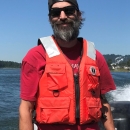In September 1999, a Settlement Agreement was signed by PacifiCorp and State, Federal, Tribal and non-governmental organizations to remove Condit Dam and reopen the upper White Salmon River to fish passage fish passage
Fish passage is the ability of fish or other aquatic species to move freely throughout their life to find food, reproduce, and complete their natural migration cycles. Millions of barriers to fish passage across the country are fragmenting habitat and leading to species declines. The U.S. Fish and Wildlife Service's National Fish Passage Program is working to reconnect watersheds to benefit both wildlife and people.
Learn more about fish passage . One of the key conservation measures proposed by PacifiCorp and the Federal Energy Regulatory Commission (FERC) is the capture of adult Lower Columbia River (LCR) fall Chinook salmon (Oncorhynchus tshawytscha) before Condit Dam is removed (projected Oct. 2010) and rearing their progeny for release back into the White Salmon River after the removal process is complete (NMFS 2006). The breaching of Condit Dam and draining of Northwestern Lake is expected to temporarily eliminate anadromous spawning in the lower river by inundating the spawning area with reservoir sediments (NMFS 2006). In the spring 2008, a decision was made by the White Salmon Working Group (U.S. Fish and Wildlife Service, Yakama Nation, Washington Department of Fish and Wildlife, NOAA-Fisheries, PacifiCorp and U.S. Geological Survey-Biological Resources Division) to perform adult lower Columbia River (LCR) fall Chinook salmon outplanting upstream of Condit Dam during the year of dam removal in lieu of adult collection and subsequent hatchery propagation. This study builds on results and recommendations presented in Engle and Skalicky (2009) that assessed several capture methods targeting LCR fall Chinook salmon for outplanting above Condit Dam in fall 2008.
A total of 688 LCR fall Chinook salmon (404 hatchery origin and 284 natural origin) were enumerated in the fall of 2009 in the lower White Salmon River at river mile 1.1 using a resistance board weir combined with a video passage system (VPS) and the White Salmon Ponds, a dormant brood stock collection facility owned by the U.S. Fish and Wildlife Service. A total of 46 hatchery origin and 36 natural origin LCR fall Chinook salmon were captured in the White Salmon Ponds over 10 days of non-consecutive operation during the 2009 study period (August 25 through October 9, 2009). Enumeration and capture of steelhead (O. mykiss), coho salmon (O. kisutch), spring Chinook salmon, upriver bright fall Chinook salmon and one pink salmon (O. gorbuscha) occurred over the study period. An estimated escapement of LCR fall Chinook salmon in the White Salmon River for 2009 above river mile 1.1 ranged between 725 – 777 using catch-per-unit effort and an area-under-the-curve estimation, respectively. A qualitative effort on how the resistance board weir may impede or affect migrating salmonids using a dual frequency identification sonar, or DIDSON, was attempted and yielded results that suggest a future, quantitative effort could be successful.
The White Salmon Ponds combined with a resistance board weir are a feasible, recommended tool for capture LCR fall Chinook salmon during the year of Condit Dam removal. An additional seining effort in the lower White Salmon River similar to, but less intensive as conducted in 2008 (Engle and Skalicky 2009), as well as earlier weir placement, closed sport fishing access in the White Salmon River above river mile 1.0, and relocation or surplusing of non-target adult salmonids are also recommended during the year of Condit Dam removal.




